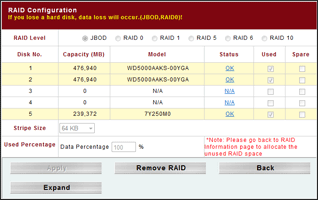Thecus N5200BR NAS Server
Storage Configuration
For configuring the hard drives, the RAID sub-menu gives the capability to create a new array and set the space allocations. We should note that multiple arrays are not possible, so there cannot be two RAID 0 arrays, and single drives cannot be configured separtely either. Once the drives are in place, any additional drives added later would be added to the current array, extending its storage capacity. The system offers an excellent choice of RAID options including:
| JBOD: |
Just a bunch of disks (1 Disk Min.) |
| RAID 0: |
Striping (2 Disk Min.) |
| RAID 1: |
Mirroring (2 Disk Min.) |
| RAID 5: |
Striping/Mirroring (3 Disk Min.) |
| RAID 6: |
Striping/Mirroring (4 Disk Min.) |
| RAID 10: |
Striping/Mirroring (4 Disk Min.) |
This is also where USB space would be specified, by first creating a RAID array and specifying a percentage for USB storage. Once built, the remaining unused percentage can be allocated for USB usage. The Folders sub-menu provides access to the system default folders as well as offering the option to create new custom folders. Both existing and new folders can be customized to control whether they are Browseable and/or Public while also setting size quotas in Gigabytes.
There is a File System Check sub-menu that cycles the system through a file system check to ensure data integrity. Another useful option is the ability to mount ISOs. This can be beneficial when using the unit in a commercial environment where installation CDs need to be accessible to multiple users or for gamers who may want to put their game ISOs on the server and install from there. There is a 50 ISO limit, however, they can reside in any folder that exists on the array. Lastly, there is the Nsync sub-menu. Nsync provides the ability to synchronize a particular folder on the server to a remote location, scheduling it to run at a set time daily, weekly or monthly. This can be useful for remote backup situations where it's important to have multiple copies of files at different locations. Nsync can also be set to use only a certain amount of bandwidth, from 256kbps to Unlimited, which can be useful if replication needs to occur during high traffic periods.
There is a File System Check sub-menu that cycles the system through a file system check to ensure data integrity. Another useful option is the ability to mount ISOs. This can be beneficial when using the unit in a commercial environment where installation CDs need to be accessible to multiple users or for gamers who may want to put their game ISOs on the server and install from there. There is a 50 ISO limit, however, they can reside in any folder that exists on the array. Lastly, there is the Nsync sub-menu. Nsync provides the ability to synchronize a particular folder on the server to a remote location, scheduling it to run at a set time daily, weekly or monthly. This can be useful for remote backup situations where it's important to have multiple copies of files at different locations. Nsync can also be set to use only a certain amount of bandwidth, from 256kbps to Unlimited, which can be useful if replication needs to occur during high traffic periods.







